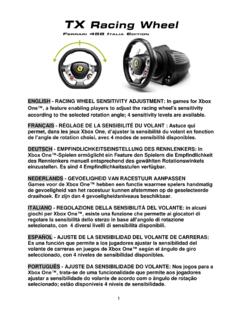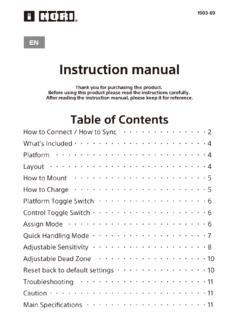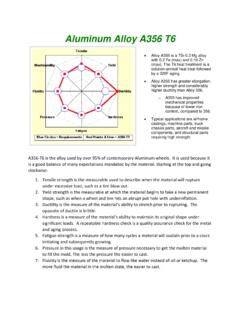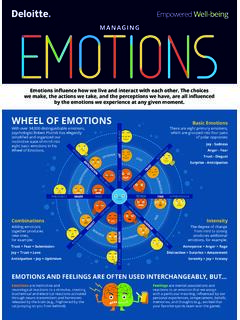Transcription of THE MEDICINE WHEEL - North Dakota
1 THE MEDICINE WHEEL The Native-American concept of the MEDICINE WHEEL symbolically represents a nonlinear model of human development. Each compass direction on the WHEEL offers lessons and gifts that support the development of a balanced individual. The idea is to remain balanced at the center of the WHEEL while developing equally the physical, mental, emotional, and spiritual aspects of one s personality. The concept of the MEDICINE WHEEL varies among Native peoples: different groups attribute different gifts to positions on the WHEEL .
2 But the following offers a generalized overview of some lessons and gifts connected with the development process. Lessons and gifts from the EAST, the place of first light, spring, and birth, include: Warmth of the spirit Purity, trust, and hope Unconditional love Courage Truthfulness Guidance and leadership Capacity to remain in the present moment Lessons and gifts from the SOUTH, the place of summer and youth, include: Generosity, sensitivity , and loyalty Romantic love Testing of the physical body/self-control Gifts of music and art Capacity to express feelings openly in ways respectful to others Lessons and gifts from the WEST, the place of autumn and adulthood, include.
3 Dreams, prayers, and meditation Perseverance when challenged Balance between passionate loyalty and spiritual insight Use of personal objects, sacred objects Understanding of life s meaning Fasting, ceremony, self-knowledge, and vision Lessons and gifts from the North , the place of winter and elders, include: Intellectual wisdom Ability to complete tasks that began as a vision Detachment from hate, jealousy, desire, anger, and fear Ability to see the past, present, and future as interrelated SOURCE: Bopp, J.,Bopp, M., Brown, L.,& Lane Jr., P. (1989).
4 The sacred tree: Reflections on Native American spirituality. Twin Lakes, WI: Lotus Light Publications. ACTIVITIES: Protect and Balance Self Print the MEDICINE WHEEL located on the next page of this document. Have the students color and label the MEDICINE WHEEL quadrants: Spiritual, Mental, Physical, and Emotional. Discuss what each quadrant represents and how they are interconnected. Alcohol is toxic to our spiritual, mental, physical, and emotional self. How does alcohol disrupt this balance? Have students work in groups and identify how substances like alcohol, affect one spiritually, mentally, physically, and emotionally.
5 What are some ways that one can protect oneself? Are you at the center and in charge of all four aspects or do you let your relationships and friends decide your emotional well-being. Storytelling Invite Elders and storytellers to discuss the art of storytelling and share oral traditions or teachings. Have students tell their own story about what they learned or share a story that was told to them. Students can also bring a significant object from home and tell the story of how they acquired the object and why it is important to them. Share a sacred teaching (Love, Respect, Humility, Honesty, Courage, Wisdom, and Truth).
6 Have older students create a story for younger children in the Native language that highlights a gift and the need for a balanced, drug-free life (Variation: Create pictograph and decode message). My Journey Have students create a timeline that reflects an important journey in their life. Who was there to help you? Was there a particular point in the timeline that was especially significant or important? What did you learn from the experience? How would you help a friend or someone else if they were going through the same thing? Have them share something about what they learned with the group.
7 You inspired Have students write a letter or create a poster of someone in their local community who has inspired them. For example, a student is inspired by his or her grandmother or grandfather to learn hunting, trapping, cooking, beading, quilting, or other traditions. A student may want to honor extended family members for helping them through a difficult time or for carrying on a cultural tradition. Students can invite this person to the classroom in order to celebrate the honor. Students can explain how they were inspired and pledge to continue stay true to self, nurture their gifts, and living a balanced, drug-free life.
8 Talking Circle Create a talking circle and discuss Alcohol, Tobacco, and Other Drug use topics such as: The dangers, harm, and negative impact of substances to your mind, body, and spirit What to do if someone you love is using How to help a friend or family in need Pride Have the students research the history of their community to include famous Native Americans (storyteller, celebrities, musicians, artists, writers, etc.), research the many contributions made by Native Americans, and facts about your family and tribe. Put together a poster presentation or electronic scrapbook that celebrates your roots!
9 Medicines Discuss the difference between traditional and non-traditional MEDICINE and their affects on aspects of self. TEACHER copy: Use the template below to create everyday lessons about making good choices, staying healthy, and living a balanced lifestyle. For example, have students think of ways to nurture their emotional, spiritual, mental, and physical self and fill in each quadrant and lead a discussion or talking circle. Native Youth Wellness Is a cultural and traditional model of lifestyle Is a holistic approach to living one s life in a good way Has four Directions.
10 Directions are interdependent Is about GOOD CHOICES and GROWING up to make your CULTURE PROUD! WALK in BALANCE SOURCE: Billy Rogers, Native Wellness and Healing Institute, 2004 non-smoker non-drinker practice safe sex exercise everyday don't eat junk food everyday body image acceptance learn from mistakes think about the future-vision creative good decision-making skills like to learn don't give in to peer pressure proud to be Native pray everyday respect all things don't hit or yell at others always try to do your best like yourself good attitude control anger share problems healthy relationships express affection EMOTIONAL (feel)









